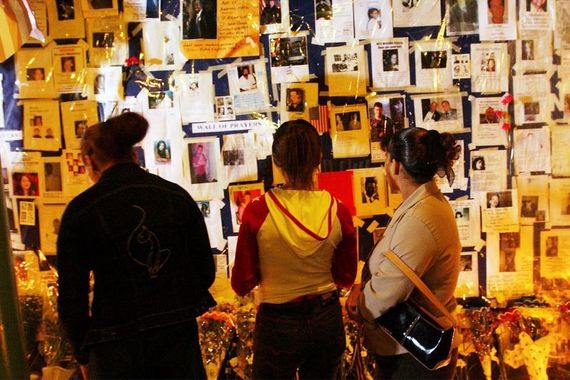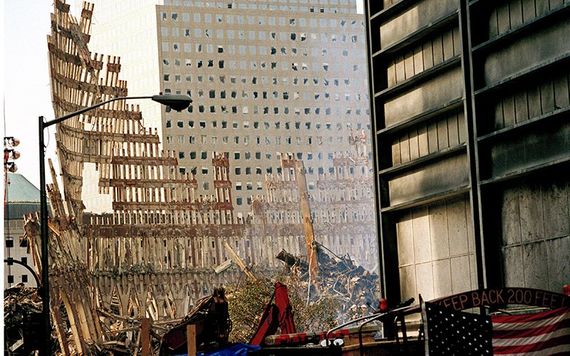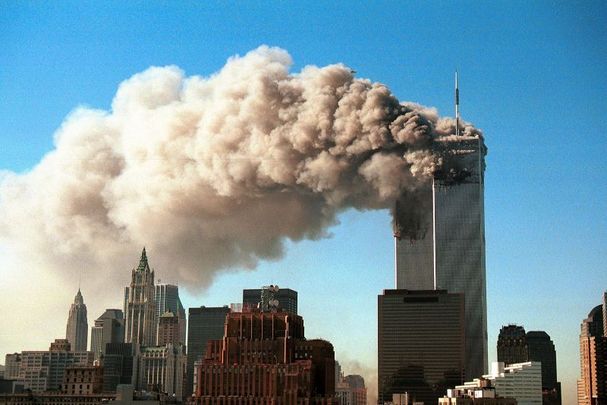The evening of 10 September was warm and still. Aoife Keane, a 21-year-old Dublin psychology student, the daughter of my friend Michael Keane, former editor of the Sunday Press newspaper in Ireland, arrived to stay with us for a few days.
It was her first time in New York. We went out onto our little balcony and she gazed up in wonder at the lights of the twin towers high above us. The building was constructed without light switches and the lights were never extinguished, day or night. She said, “I am going to go to the top tomorrow morning.”
Aoife was still asleep the next day in the guest room, and Zhanna, my wife, had gone to her office uptown, where she worked as director of development for the Geneva-based International Baccalaureate, when American Airlines Flight 11 crashed into the north tower at 8.46 am, laden with 10,000 gallons of fuel.
The plane had flown past my apartment block, but downtown Manhattan is a very noisy place and I don’t remember hearing it as I worked on an article on how the economic downturn was affecting New York’s restaurants.
When the bang shook our building, I thought, from years of monitoring the sound of explosions, that it was a bomb.
I jumped up and saw a gaping hole near the top of the north tower, the nearest of the two towers, with flames and black smoke pouring out. I made several quick telephone calls, to my news desk, to my Irish Times colleague Paddy Smyth in Washington DC, and to Zhanna.
I also called RTÉ, to which I often gave interviews, to alert them to what had happened. It was almost two o’clock in the afternoon in Ireland. They asked me to go on air immediately.
Just before the broadcast, I heard the RTÉ announcer report a newsflash about an aircraft hitting the World Trade Center. Only then did I realize what it was.

The public scan fliers of missing people after 9/11 in New York.
I woke Aoife after the interview. “Get up, something terrible has happened,” I said.
At this stage, I didn’t know if it was an accident or an attack. From the living room window, I trained my old pair of Russian military binoculars on a man at a window of the north tower. He was standing on a window ledge of the 92nd or 93rd floor, hanging out above Vesey Street 300 meters below. There was black smoke pouring from the row of narrow, vestry-like windows beside and above him. He was waving a white cloth. It looked like his shirt. He was in his thirties, I would say, and a little overweight.
Then Aoife said with a gasp, “There’s another plane!” United Flight 175 skimmed over the Hudson River to our right and smashed into the south tower between the 78th and 84th floors, creating a huge orange and black fireball and showering Broadway with flaming debris.
There was no doubt now that this was an act of war and I recall thinking that there would be terrible retribution.
We watched helplessly as dozens of heart-wrenching individual tragedies were enacted within our gaze. More people appeared at upper-story windows crying soundlessly for assistance. We saw five fall to their deaths in a short space of time.
Flames began to leap from the side of the nearby Marriott hotel, drenched with burning fuel. About two dozen fire engines came wailing down West Side Highway and screeched to a halt outside the north tower. Scores of firemen ran into the buildings laden down with gear.
After a few minutes, I decided to go to the Twin Towers myself and took the lift to the ground floor 42 stories below. As I passed through the lobby of my building, a woman was in hysterics; her husband worked in the World Trade Center (he survived).
I went to the corner of Vesey Street and West Side Highway. People were running in panic away from the burning towers. Others stood in shock, hands over open mouths, heads craning upwards. A security man pushed me back. Someone screamed, “Oh my God, people are jumping!” More bodies were falling onto Vesey Street and onto the plaza between the towers.
Some fell with arms extended as if for a crucifixion, taking what seemed like ten seconds to reach the ground. I thought I had better get back to my office. Frankly, I was scared that the towers would collapse on top of me or that I would be hit by falling debris.
Also, police officers were closing off the streets and evacuating apartment buildings. I was worried that I would not be allowed back to my office and I felt responsible for Aoife, who, on her own, was witnessing scenes of unimaginable horror on her first morning in New York. I made it back minutes before police ordered all residents of the building to leave.

The aftermath of Sept 11 terror attacks.
I only found out later that the building manager, Rosie Rosenstein, a friend with whom I would occasionally sit on a bench outside and marvel at our good fortune to live in such a wonderful neighborhood, decided not to mention my presence to the police, because he knew how important it was for me to continue reporting.
Back at my vantage point, I noticed a helicopter buzzing low over the north tower. I thought: why doesn’t it take people off the roof, or lower a rope to the windows? I couldn’t know that the doors to the roof were locked and the pilots could not approach because of the heat.
Just before 10 o’clock, I saw office workers who had been milling around the lawns of Battery Park suddenly turn and run as fast as they could. The south tower had started to fall. The top seemed to tilt over towards the river, and then crush the whole building beneath it. Jagged pieces of the tower the size of suburban houses crashed onto two fire engines and engulfed rescue workers on the roadway. A huge cloud of dust and ash rose from the impact, enveloping the Embassy Suites Hotel below and the 50-story buildings of the World Financial Center.
I was by now completely numb, working on my reflexes, typing and making calls at high speed. The story was so enormous, I just had to keep my emotions in check, because my responsibilities to my newspaper were so great.
As the dust cleared, I scanned the windows of the still-standing north tower for the man who had been waving an hour before. Incredibly, he was still there, holding desperately on to a pillar between two of the narrow windows, as smoke poured out past him.
He most likely worked for the Marsh & McLennan insurance company, which had offices on several floors at that level. I will never know. As I watched, two bodies fell past him from the higher floors, then two more, and I saw that the tower was shuddering violently.
Much has been written about people “jumping." I believe that many were clinging desperately to life, but at that moment were simply unable to hold on. Intense smoke and heat and shaking gave people little choice. They could not breathe and had to crowd onto the window ledges. About 200 people fell to their death that morning, most from the north tower. None were ever classified as “jumpers”, i.e. people who deliberately commit suicide.
The north tower was now in its death throes. The end came at 10.28 am. The 110-story tower imploded floor by floor, spewing out clouds of debris and atomized flesh. The man I was watching descended into the roaring blackness as if on a down elevator. I felt a connection with him. I had been watching him, on and off, and somehow felt he had been looking back at me. It left me with a feeling of guilt in the pit of my stomach, an awful sense of inadequacy and helplessness at not being able to do anything for him. My feelings about that day often come down to that one person and how he suffered.
As the yellow-brown cloud billowed out, rescue workers fled towards the river. Some jumped in and were pulled onboard ferry boats.
The dense mass of dust approached our apartment until we could almost reach out and touch it. Then it stopped, and retreated slowly, pushed back by a steady breeze from the Hudson. It left a thick layer of ash and dust coating the streets and parks below. It covered the broken bodies on Vesey Street like a shroud.
The grey of the landscape was broken by orange-red flames licking up from cars at Vesey and West Side Highway which had been set on fire by the burning debris. More cars were alight on Greenwich Street. The wide walkway across West Side Highway from the Winter Gardens lay broken on the highway. Beyond it, the Greek Orthodox Church had been crushed out of existence. Thousands of scraps of paper floated in the air like giant snowflakes. Some firemen stood in Greenwich Street, stunned, coated from head to foot in dust.
The local telephone lines were cut when the towers collapsed, and the mobile telephone network was overwhelmed, so I could not contact anyone in New York after that.
But the long-distance service and broadband still worked. I was able to call my family, keep up contact with my office in Dublin, send digital photographs, and do more radio interviews throughout the afternoon. People who have forgotten anything I ever wrote tell me they recall these broadcasts. I always avoided emotion in radio interviews, but that day, when describing events on RTÉ, I remember involuntarily saying “Oh my God, this is terrible” as I saw more bodies falling to the pavement below.
All afternoon I struggled to match the drama and awfulness of the occasion in my reports. Aoife had a shower around three o’clock. For months afterward, it bothered her, irrationally, that she had done that, while so many people had died outside the windows.
Throughout this time a fire raged through No. 7 World Trade Center, a 47-story building that housed the diesel fuel tanks of the city’s emergency command center, inexplicably located in this likely terrorist target by Mayor Rudolph Giuliani against the advice of his officials, though he would deny that later. At 5.20 pm, it collapsed, falling straight down onto Greenwich Street. On its own, such an event would have made world headlines. In falling it smashed an electricity substation and cut off the electricity to our building. It was time to leave
Carrying a computer and overnight bags, we stumbled down 41 flights of concrete emergency stairs in the dark. I kept thinking what it must have been like for those fleeing down the stairwells in the World Trade Center. I found Zhanna at a police barrier outside; I hadn’t been able to get through to her all afternoon and she had managed to make her way downtown past several roadblocks.
The three of us trudged north through streets clogged with emergency vehicles and exhausted firemen. Beyond the outer police cordon, groups of residents stood looking in stupefaction towards the smoking ruins. A car driven by Chris Coyne, a worker from St Vincent’s Hospital, stopped and took us as far as Greenwich Village. They had been prepared for mass casualties, he said, but few were admitted. People either died or escaped.
Though within walking distance of the gigantic pyre, a few people were dining at open-air wine bars on 10th Street in the heart of Greenwich Village, as if nothing had happened. We met up with Irish Times stringer, Elaine Lafferty, for a kerbside meal at a tiny restaurant called The Place. The actress Helen Hunt and another woman were at the next table. Here, a rather surreal event took place, given the day that was in it. A fight broke out between a waiter and another diner, which spilled past us onto the pavement. We abandoned our table and Helen Hunt disappeared along the narrow street as chairs and bottles flew through the air. Someone said, “Get the cops,” as if there would be any available police to tackle a minor fracas, which in any event ended almost as soon as it had begun.
We got another ride uptown and managed to find rooms in the W Hotel on Lexington Avenue in midtown Manhattan. I thought we might be able to return to our apartment the next day but we were to spend ten days there.
I turned our room into the temporary Irish Times office. After a week, a bill was slipped under the door asking for immediate payment, since the amount exceeded $5,000, mainly due to the frequent use of the international line to which I had hooked my computer. I went to see the manager in the lobby, explained my situation, and asked if he could cut a deal on the telephone charges. He beckoned me to sit down. “I’m not going to allow you to leave this hotel . . .” he said (my heart sank), “. . . until we both agree on a reasonable charge for the telephone.” He was as good as his word. When we were allowed back to Battery Park City, he cut the bill almost in half.
*Originally published on IrishCentral in 2016, updated in 2023.




Comments